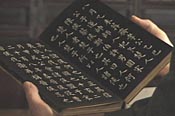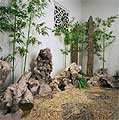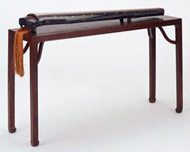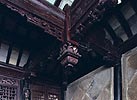Interview with Robert Jacobsen
Curator of Asian Art
1. What is this room and how does it fit in with the larger building it would have been a part of?
In a cultured household in traditional China—a Confucian household—the library would have been the most important room in the house. After the great hall, it would have been the most important room, for certain. And it was here that the trained scholars, often working for the government as part of the bureaucracy, would keep their art. They would keep their books here. They would do their writing here. It could be poetry. It could be court memorials, but this becomes the intellectual crossroads of the home, and—to a degree—of Chinese culture.
2. What about the furnishings?

(1) Scholar's studies in the Ming and Ch'ing dynasties were furnished according to simple tastes.
During the late Ming and early Ch'ing dynasties, rooms like this were put together by scholars—members of the Literati—and typically furnished with rather simple tastes: beautiful proportioned hardwoods, and cabinets that were simpler rather than ornate in decoration and overall appearance.(1)
3. What does the term "Literati" mean?
It's a whole class of Chinese men. They all were trained in Confucian classics—some served the state as scholar officials—and all played the reclusive role of retired gentlemen.
4. There are many natural elements in and around this room.
They would collect objects of nature, like great garden rocks.(2) The big rocks represented actual mountain landscapes of China. They would typically want to have plantings of bamboo and perhaps a few other plants just outside their window. Nature was very important to them. It was a focal point. It was a meditative process to view and think of nature.
And, of course, the Literati are the great landscape painters of China, so they were concerned with nature in much of their works. They were also often the nature poets of China, so they were interested in creating verse around landscape, the dynamic forces of the universe that nature and landscape represented to them.
5. Were they artists in the same way we think of artists today?
It's important to keep in mind that these scholar artists were not professionals. They prided themselves on being amateurs, on the fact that they didn't have to sell their works or pander to a mass audience.

(2) Rubbings taken from famous stone tablets were often turned into books.
Most of their paintings are quite small—no larger than books, in many instances. They were very, very interested in collecting and studying their own history. Famous inscriptions were often taken from carved stone tablets, and these rubbings turned, then, into books that would be kept in the library.(2) These were sources not only of history and philosophy, but also of writing styles of past masters.
So we see a combination of this organic taste, this interest in nature, this amateurism and the interest in books and ancient China, all come into play in the type of painting they produced, which is something that was based on the brushwork of prior masters.
6. Lacking a mass audience, what became of their works?
Their objects were passed back and forth amongst one another. These artists painted for other artists in their circle, or friends of theirs. On occasion, pieces could be commissioned for someone's birthday, or an anniversary event or some sort of government award. The art was used that way, but it wasn't done wholesale for a mass market, for popular consumption. That meant that the paintings were often very small. They would be viewed by only one or two people at a time. They were hardly ever used as decoration. In fact, they were kept more like books in a library, which is why the library becomes the repository of their scrolls, their albums and their fan paintings.
7. So these scholars were both artists and collectors?
They did not collect huge numbers of things, by and large. When we say art collecting, we're talking about a few old things; many old books, to be sure—that counted—but ancient bronzes and ancient jades would be collected and used occasionally as display items. A cabinet could have held many treasures, but only a few would be pulled out and put on view during the various seasons of the year.
8. Back in the garden, it appears that everything is very carefully placed.

(3) Nature—in particular rocks from Lake T'ai—were a focal point for the study.
They loved ancient rocks. Perforated stones from Lake T'ai are what are decorating the gardens. The big centerpiece stones were dredged up from the shoreline and arranged in gardens to represent the actual mountain ranges of China proper. Other kinds of stones from farther West were collected and prized for their ability to evoke an ink landscape.
9. You mentioned writing, painting, and poetry. Were these scholars also interested in music?
Confucius said that a true gentleman—a refined gentleman—was going to be a poet, a painter, a good archer—remember, he lived during the Bronze Age—but he also had to know and understand music.

(4) The ch'in—a kind of zither—was the scholar's preferred musical instrument.
The scholars took this seriously, and an ancient zither called the ch'in—an instrument that dates back to China's Bronze Age, in fact—was the instrument of choice. So, this too would be found in a library, generally hanging on a wall or placed on the table at which they were played, as a reference to the refined intellectuality, culture, and sense of history that any true Literati artist would have.
10. Could you say more about the house itself?

(5) This study was the most elaborately decorated room in its original house.
The late 18th century house that this room was taken from still stands in China. It was the fanciest room in the house and amongst the smallest of the rooms in the house, so we know that they concentrated their efforts on this room. The decorative work in the support frame, the ceiling beams,(5) and the latticework in the windows are far fancier than in other rooms in the house.
11. How does this compare with the museum's other Chinese room, the reception hall?
Unlike the Ming Dynasty Wu family reception hall, this Ch'ing study is not a freestanding structure that was linked up, as the earlier Ming house linked its structures up. This is actually a room taken from the corner of a very large, two-story walled structure. In fact, the bedroom is still above the library, just as we found it here. There was a small room upstairs that was reached through the garden doorway.
The study had a rock garden on either side of it. This one we were able to recreate with its pebble floor. Although the stones had been taken away long ago, we were able to find old garden stones and reinsert them where they would have been correctly placed.
12. Would the room have been as open to the elements as it appears here?
They were open to the elements, because a person needed the sun and the rain to keep the bamboo and other plants growing. So our scholar had his table almost in the center of his room. He had his book cabinets to either side. He had paraphernalia spread out. And he had views of nature before him and behind him—facing north and facing south.
The room itself is done in an individual manner. The artist—the patriarch perhaps, the scholar of the household—really was allowed to arrange this room in an independent manner. He was in charge of collecting what he wanted and placing these things where he wanted to look at them.
13. So the arrangement is not formally dictated.
The Wu house, being a reception hall, is far more formal. You had very little choice of where things went. It was more dictated to you by Confucian custom and traditional family worship. If you were the matriarch or patriarch of the household and had that exalted couch to sit on as head of the family, you would have been very, very formal. And you would have carried on conversations in a socially correct manner.
This room is almost the direct opposite. Here you got to be yourself—kick off your shoes, maybe put your feet up a bit, lean back, think, read, and enjoy nature. Because it was all around you in some way or another, via the painting, the stone, a garden rock or a poem about nature, perhaps. It was all in this room.